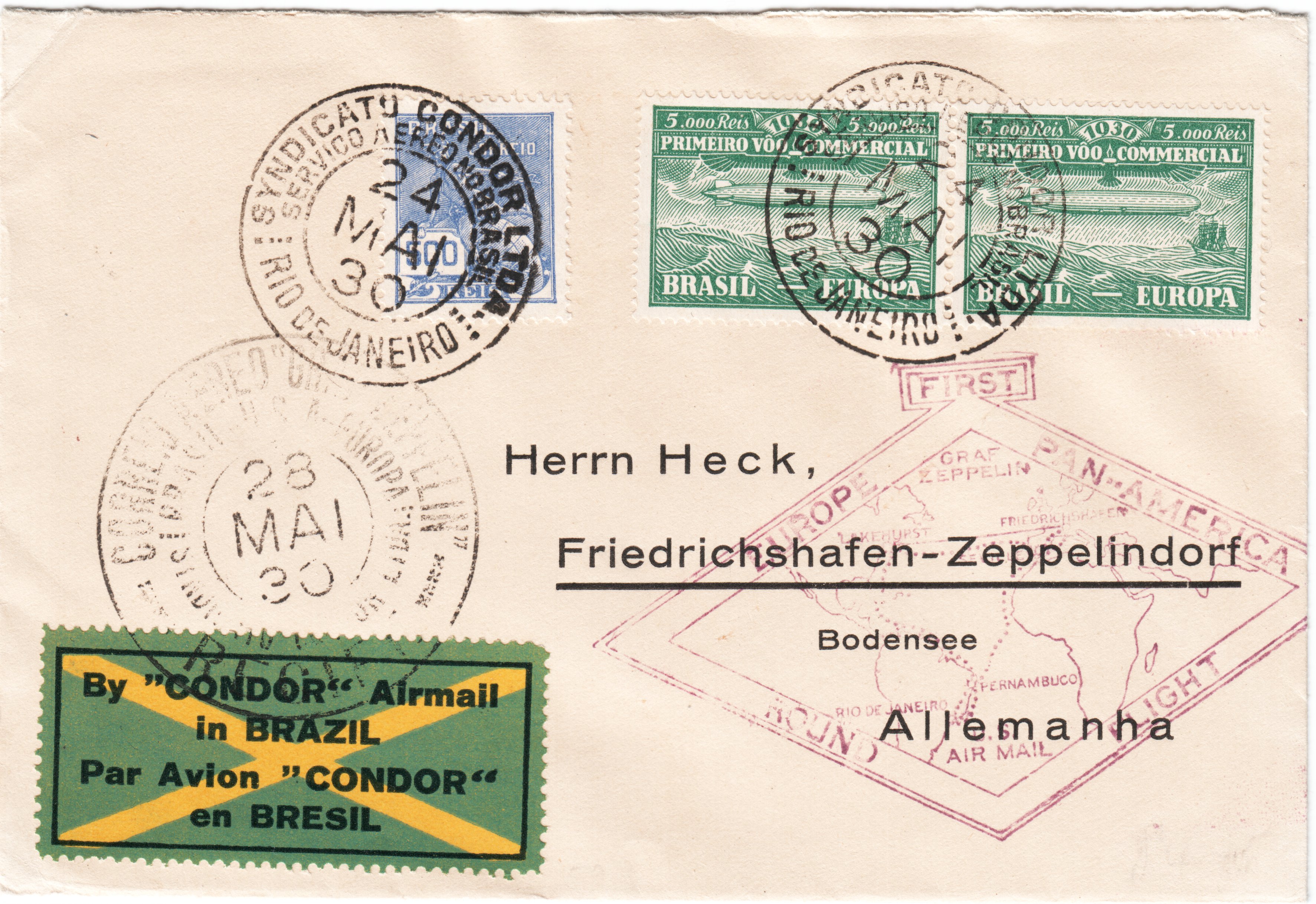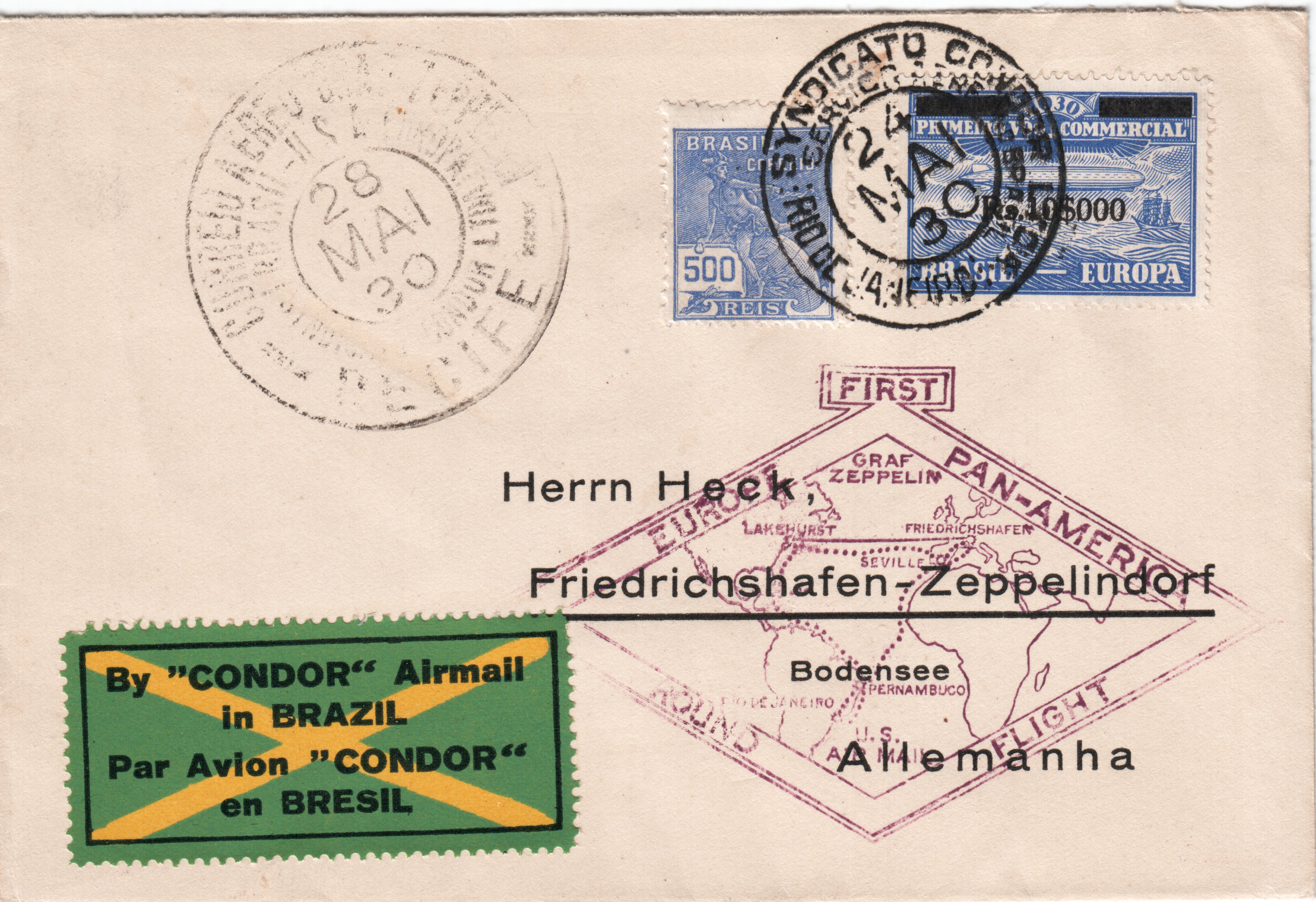|
© Dr. Artur Knoth |
Brazilian Philately: The Pan Am Zeppelin Flight of 1930 |
The Heck/Friedrichshafen Covers
As with many of the German dealers, Heck of Friedrichshafen also utilized the basic preprinted envelope style that they all had in common. In fact, the cooperation went as far that Sieger actually never produced a 59C version for his costumers, using instead a Heck cover as demonstrated in an ad of Sieger's at that time. Heck covered the basic 59A to C plus 59H with an improvised card version for 59G (5$000/20$000).
59AA
Perhaps one intriguing aspect of Heck is that he didn't seem to have ordered any preprinted postal type cards. To create covers for the 5$000 stamp, he instead used 2 copies on an envelope to make up the 10$000 letter rate. This could help explain why the 5$000 stamps ended up being sold out fairly early, if a dealer with his lump of covers used up these stamps in such numbers. And to complicate things further, we have here another case of where several pairs of hands were at work preparing and canceling the covers. There were at least 3 people/batches involved during the cancellation process. Figures 1 through 3 demonstrate this aspect. In the first two cases, both have the rdj7ab cancel (seven dots, thick inner circle), but in the second case the cancels are shifted to the left, instead or two cancels spread over the three stamps (Fig. 1), the Brazilian stamp gets basically socked on the nose and the Zeppelin pair in the middle.
The third version (Fig. 3) has a completely different cancel type, rdj4 (4 dots), and is canceled like the covers in Fig. 2, but even more pronounced.
 Figure 3: Covers canceled
with rdj4.
Figure 3: Covers canceled
with rdj4.
The reverse of the covers all have back cancels from Friedrichshafen, yet while the vast majority of these covers have the small circle Friedrichshafen (Fig. 4) a very few are found with the larger *b version (Fig. 5)
59B
As a whole one must admit that the Heck covers with the 10$000 stamps are a smeary mess. The primary Rio cancels, as well as the violet cachets, are usually quite heavily inked and smeared. The main variety one can find here is that the Recife cachet comes in two versions, one having more dots than the other. But on top of that, it seems one person who applied his version of the Recife cachet (six dots, left and right), did right-side-up, so to speak (Fig. 6). The other cover type seems to often almost completely upside-down or at least heavily rotated Recife cancel – five dots on both sides (Fig. 7).
59C
Here, in a case very similar to 59AA, once again there are 3 varieties, Figs. 8 to10. Again some covers have a single cancellation strike, but there were two different devices used, and some where the cancellation was applied twice.
59G
Finally, the case of the covers for the 5$000/20$000 stamp is somewhat simpler. A lack of preprinted postcards caused the use of the 59AA format. Maybe the people in Rio preparing the covers either ran out of preprinted envelopes, or it was just getting too expensive to make a big batch of 59GG. So they went to a stationary shop in the area downtown, the papelaria Botelho, purchased a bunch of blank cards, and created the 59Gs one finds today. But here we also find another confirmation that many hands were at work. There are two major varieties of these covers. One part has the address typed, whereas the others it was written by hand. An example of each in Figures 11 and 12.
59H
Here once again it was possible to use what was left of the preprinted envelopes, since 10$000 was the letter rate. There no varieties as such among these covers except that they were canceled using the rdj3 device which is notorious for its rotating inner part. As Figure 13 illustrates, the center has rotated roughly 45°, but values of 90 or even 180 (upside-down relative to the city name) can be found.
 Figure 13: Typical 59H
version with rotating center cancel.
Figure 13: Typical 59H
version with rotating center cancel.